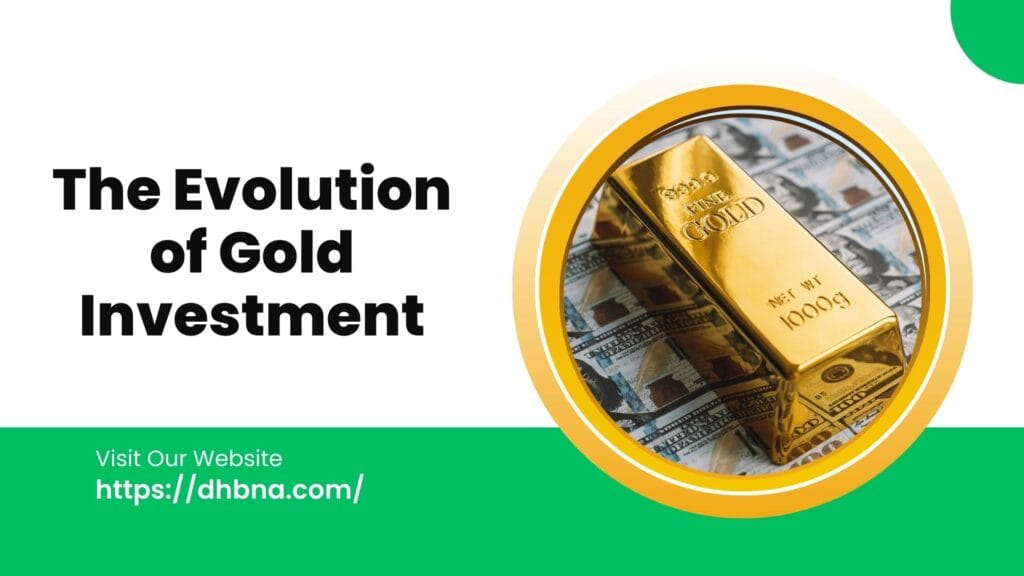Introduction: The Timeless Appeal of Gold Investment
Gold has long been considered one of the most reliable assets for preserving wealth. Throughout history, it has played a crucial role in economies worldwide, serving as currency, a store of value, and a hedge against inflation. In modern times, the landscape of gold investment has evolved significantly due to technological advancements, economic shifts, and changing investor preferences.
As financial markets become increasingly complex, gold continues to adapt to contemporary investment strategies. This article explores the evolution of gold investment and the modern trends shaping its future, from traditional physical ownership to innovative digital assets.
The Historical Role of Gold Investment
Gold as a Store of Value
For centuries, gold has been regarded as a symbol of wealth and stability. Ancient civilizations such as the Egyptians, Romans, and Chinese used gold as currency and a means of trade. Its rarity and intrinsic value made it a preferred asset for wealth preservation.
Even with the transition to paper money, gold retained its importance. The Gold Standard, which linked currency values to gold reserves, was a fundamental monetary system until the 20th century. Although the Gold Standard was eventually abandoned, gold remains a crucial component of global financial markets.
Gold in Times of Economic Uncertainty
Historically, gold has thrived during economic turmoil. During periods of inflation, currency devaluation, or geopolitical instability, investors turn to gold as a safe haven asset. For instance, during the 2008 financial crisis, gold prices soared as investors sought security amid collapsing stock markets.
Today, the perception of gold as a hedge against uncertainty continues to influence its role in investment portfolios worldwide.
Modern Trends in Gold Investment
1. The Rise of Digital Gold and Gold-Backed Cryptocurrencies
With the advancement of blockchain technology, digital gold investments have emerged as an innovative alternative to traditional gold ownership. Gold-backed cryptocurrencies such as PAX Gold (PAXG) and Tether Gold (XAUT) allow investors to buy and trade gold in fractional amounts without physical storage concerns.
Benefits of digital gold include:
- Increased Accessibility: Investors can buy small fractions of gold, making it more affordable.
- Enhanced Liquidity: Unlike physical gold, digital gold can be traded instantly.
- Security & Transparency: Blockchain technology ensures ownership verification and prevents counterfeiting.
As digital assets gain mainstream adoption, the demand for gold-backed cryptocurrencies is expected to grow.
2. Gold Exchange-Traded Funds (ETFs)
Gold ETFs have revolutionized gold investment by offering a convenient way to gain exposure to gold prices without the complexities of owning physical gold. Popular ETFs such as SPDR Gold Shares (GLD) and iShares Gold Trust (IAU) track gold prices and allow investors to trade them like stocks.
Advantages of gold ETFs include:
- Lower Costs: No need for storage or security measures.
- Ease of Trading: Investors can buy and sell ETFs through standard brokerage accounts.
- Portfolio Diversification: ETFs provide an efficient way to include gold in an investment portfolio.
Given the increasing popularity of ETFs, they are likely to remain a dominant force in gold investment.
3. Sustainable and Ethical Gold Sourcing
Environmental and ethical concerns have prompted a shift toward sustainable gold investment. Consumers and investors are becoming more conscious of how gold is mined, leading to a rise in demand for ethically sourced gold.
Key trends in sustainable gold include:
- Fair Trade and Conflict-Free Gold: Certifications such as the Fairmined and Fairtrade Gold labels ensure responsible sourcing.
- Recycled Gold: The recycling of gold from old jewelry and electronics reduces environmental impact.
- Green Mining Technologies: Companies are investing in eco-friendly extraction methods to minimize carbon footprints.
Sustainable gold investment is likely to gain momentum as investors prioritize environmental, social, and governance (ESG) considerations.
4. Central Bank Gold Reserves
Central banks worldwide continue to accumulate gold reserves, reinforcing its importance as a financial safeguard. Countries such as China, Russia, and India have significantly increased their gold holdings to reduce reliance on the US dollar.
Reasons for central bank gold accumulation:
- Hedge Against Currency Depreciation: Gold serves as a counterbalance to fluctuations in fiat currency values.
- Diversification of Reserves: Reducing dependency on foreign currencies enhances financial stability.
- Geopolitical Strategy: Gold ownership provides economic leverage in times of global uncertainty.
The trend of central banks stockpiling gold is expected to persist, further strengthening gold’s position in global finance.
5. Gold Investment in the Era of Inflation and Interest Rates
With inflationary pressures rising, gold remains a favored asset for hedging against the devaluation of fiat currencies. Historically, when inflation rates surge, gold prices tend to increase.
- Low-Interest Rate Environments: Gold thrives when interest rates are low, as there is less opportunity cost for holding non-yielding assets.
- High Inflation Periods: When inflation erodes purchasing power, gold acts as a store of value.
Current macroeconomic trends suggest that inflation concerns will continue to drive demand for gold in the coming years.
6. Technology and AI in Gold Trading
The integration of artificial intelligence (AI) and data analytics in gold trading is reshaping investment strategies. AI-powered algorithms analyze market trends, predict price movements, and execute trades with high efficiency.
- Algorithmic Trading: Automated trading bots execute gold trades based on market signals.
- Predictive Analytics: AI tools assess historical data to forecast future price trends.
- Risk Management: AI enhances risk assessment by analyzing geopolitical and economic indicators.
As technology evolves, AI-driven trading platforms will play a significant role in the future of gold investment.
The Future of Gold Investment
As the financial landscape transforms, gold investment is adapting to new economic realities. The emergence of digital gold, sustainability initiatives, and AI-driven trading are shaping the future of how investors interact with gold.
Key Takeaways:
- Gold remains a vital asset for wealth preservation and economic stability.
- Digital innovations, including gold-backed cryptocurrencies and ETFs, enhance accessibility and liquidity.
- Sustainable gold sourcing aligns with the growing demand for ethical investments.
- Central banks continue to reinforce gold’s value as a hedge against currency risks.
- Technological advancements in AI and data analytics are revolutionizing gold trading.
As investors navigate the complexities of modern finance, gold’s enduring appeal ensures it will remain a cornerstone of investment strategies for generations to come.
Conclusion
The evolution of gold investment reflects broader economic, technological, and environmental shifts. While traditional forms of gold ownership remain relevant, modern trends such as digital assets, sustainable sourcing, and AI-driven trading are reshaping how investors approach gold.
Whether you are a seasoned investor or exploring gold investment for the first time, staying informed about these trends will help you make strategic decisions in an ever-changing financial world. As gold continues to adapt, its role as a secure and valuable asset remains unwavering in the face of future challenges.
Discover more from Dhbna
Subscribe to get the latest posts sent to your email.



